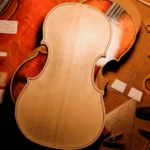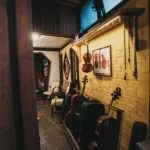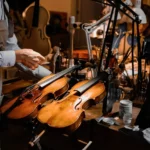Luthier in Italy: What makes Cremona the global reference for violin making
Back to BlogA city that resonates across centuries
Cremona, Italy, is not just a town—it’s the global heart of violin making. For centuries, this Renaissance city has nurtured the craft of Cremonese luthiers whose violins set the gold standard in tone, technique, and tradition. To walk through its narrow streets is to walk through the living memory of Stradivari, Guarneri, and Amati.
The Legacy of the Cremonese Masters
The origins of modern violin making trace back to Andrea Amati in the 16th century. His designs became the blueprint for the modern violin. His descendant Nicolò Amati elevated the craft, training future greats like Antonio Stradivari, whose violins are globally revered for their balance, resonance, and visual harmony. Guarneri del Gesù, in contrast, introduced a powerful tonal depth that soloists continue to seek.
Each master left unique signatures: from scroll carving to purfling details, from varnish tones to arching techniques. These instruments are not just rare—they continue to influence musical interpretation centuries later.
Why Cremona? A unique convergence of resources and culture
Cremona offered the perfect mix of resources and culture. Close to Alpine forests, it provided access to the highest-quality spruce and maple, essential for soundboards and backs. A rich guild culture, Renaissance values, and humanistic artistic thought nurtured a fusion of science, music, and craftsmanship.
Even the city’s architecture contributed: spaces like Teatro Ponchielli were designed for acoustical clarity, subtly influencing how instruments were built and heard.
The modern luthier school of Cremona
Cremona is no museum piece—it remains a vibrant hub of violin making. The Scuola Internazionale di Liuteria continues the master-apprentice tradition with students worldwide learning baroque carving, hand-varnish mixing, and modern acoustic analysis.
What defines Cremonese training today is more than tradition: it is a philosophy of silence, patience, and intuition. Luthiers “listen” to the wood, developing a sensitivity to tone that transcends measurement.
A destination for collectors, musicians, and historians
Every year, musicians, historians, and collectors make pilgrimages to Cremona. They come not only to acquire rare instruments or commission new ones, but to experience the culture of violin making firsthand. The Museo del Violino offers insights into the lives and legacies of historic luthiers. Workshops throughout the city remain open to consultation, tonal adjustment, and restoration.
Amorim Fine Violins honors this legacy by working with artisans who trained in Cremona, and by restoring instruments whose origin can be traced back to this sacred town. For those who believe in sound as heritage, Cremona is the natural reference.
The Eternal Craft of Cremona
Cremona is not just where violins were perfected—it is where they are continually reimagined. Its luthiers do not merely replicate, they reinterpret with care, bringing past and present into harmony. At Amorim Fine Violins, we see Cremona not only as a place, but as a philosophy: one rooted in excellence, patience, and the pursuit of sound that endures.
To experience the soul of violin making, we invite you to explore Cremona through our eyes—and our instruments. Learn more about our approach to craftsmanship and restoration services rooted in this timeless tradition.









